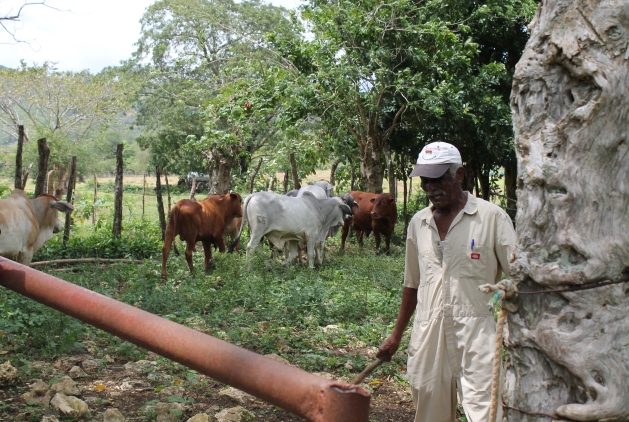Jamaica Walking a Tightrope Between Boosting the Economy and Cutting Emissions in COVID-19 Era

KINGSTON, Aug 30 (IPS) - Even as COVID-19 walloped Jamaica’s economy last year, the government overhauled its energy emissions milestones to create what many described as a post-pandemic recovery package, based on stronger carbon targets for the farming and forestry sectors.
According to the plan, the country would reduce emissions from both sectors by almost a third over the next decade, by optimising water and energy use and diversifying food production.
Released at a time when most countries around the globe struggled to manage their economies during the pandemic using measures that were expected to set back their sustainability goals, experts hailed the plan as a game changer for a country in a steep economic decline resulting from COVID-19.
Climate change expert Carlos Fuller said the new measures “will create new economic opportunities and generate employment for Jamaicans.”
Changes in land use, for development and increased agricultural activities, and reducing deforestation will cut emissions up to 28.5 per cent by 2030, according to the plan, which satisfies both local and international targets. Agriculture currently contributes about six per cent to Jamaica’s total emissions, while land use change and forestry account for 7.8 per cent.
Jamaica is one of the Caribbean’s small island developing states (SIDS). On Monday and Tuesday, representatives of the 38 SIDS worldwide, UN agencies and civil society will gather in person and online to discuss how they can kickstart their economies post-COVID-19 in order to attain the Sustainable Development Goals (SDGs) by 2030.
The SIDS Solution Forum is organised by the UN Food and Agriculture Organisation in partnership with the UN International Telecommunications Union and co-hosted by the Government of Fiji.
Other current investments in Jamaica have made climate data collection, modelling and analysis priorities. Projects like the Climate Data and Information Management Project should help to improve the collection and analysis of climate data while strengthening early warning systems. The Disaster Vulnerability Reduction Project is expected to enhance physical resilience to disasters.
Co-heads of the Climate Studies Group at the University of the West Indies, Dr Michael Taylor and Dr Tannecia Stephenson, recently deciphered the latest report of the Intergovernmental Panel on Climate Change in terms of what it could mean for the region.
“The intensity and frequency of heat extremes in the Caribbean are increasing and will continue to do so. It will impact energy use, demands for water, agricultural production among other things,” Dr Taylor said.
Jamaica’s emissions and development goals are tied together in the country’s Vision 2030 Development plan, an ambitious guide for this highly indebted nation’s development. Launched in 2014, the document aims to make “Jamaica the place of choice to live, work, raise families and do business.”
There have been tweaks, updates and a Road Map, but Vision 2030 remains grounded in four interrelated national goals: Jamaicans are empowered to achieve their fullest potential, society is secure, cohesive and just, the economy is prosperous, and the country has a healthy, natural environment.
In pursuit of the Vision 2030 aims the results have been mixed, said Wayne Henry, Director General of the Planning Institute of Jamaica (PIOJ), the agency tasked with tracking the implementation of the SDGs.
In his September 2020 overview of SDG implementation, Henry noted that Jamaica has recorded positives in the social sector, accountability and governance. For example, there is continued focus on gender equality and the empowerment of women. According to the International Labour Organization, 59.3 percent of managers in the country are women.
But Jamaica has struggled, Henry said, in the areas of security and safety, environmental sustainability and the rate of non-communicable diseases. The murder rate has hovered between 47 and 47.7 per 100,000 in recent years, diabetes and hypertension rates have climbed alarmingly in the 15-and-over age-group, and overall environmental performance has fallen.
Even as the systems for SDG implementation are woven into the national development strategies, the COVID-19 pandemic has exposed the weaknesses of economies like Jamaica’s. According to Henry, the pandemic shows “how quickly a development path can be challenged.”
COVID-19 brought the world to a standstill and in its wake upended the lives and livelihoods of thousands in the Caribbean, shuttering entire sectors that depend on tourism and according to the PIOJ, contracting the Jamaican economy by 10 percent.
With tens of thousands of jobs lost, the government turned to the island’s fast-expanding business process outsourcing (BPO) sector as a much-needed source of jobs, providing a level of diversification from the agrarian society of old. Initially focused on call centres, the sector has expanded to include to more specialised areas including accounting, human resources management, digital marketing, animation and software development.
But the sector’s employers are prone to COVID-19 outbreaks, and its dependence on the existing fossil fuel-based energy sector is a negative factor for a country keen on cutting emissions.
Still, Jamaica may well have captured the essence of the SDGs by balancing the temporary growth from the BPO sector with its commitment to reduce energy costs and diversify the fuel mix. It plans, for example, to increase the share of electricity generation from renewables from 9 percent in 2016 to 30 percent by 2030. And in 2019, the government commissioned a 36-megawatt wind farm, which is expected to reduce greenhouse gas emissions by 66,000 metric tons of CO2 equivalent per year, equal to taking roughly 13,000 cars off the road.
© Inter Press Service (2021) — All Rights Reserved. Original source: Inter Press Service
 Global Issues
Global Issues